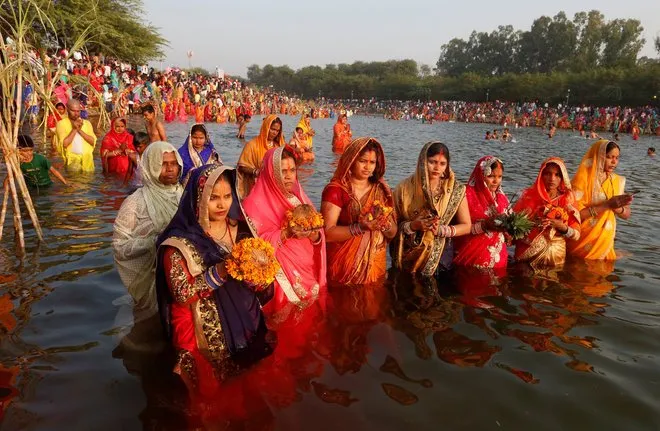Chhath Puja: A Sacred Hindu Festival Dedicated to the Sun God
Chhath Puja is one of the most ancient and significant festivals celebrated in India, especially in the states of Bihar, Uttar Pradesh, Jharkhand, and parts of Nepal. It is dedicated to the worship of the Sun God (Surya) and his sister Chhathi Maiya, who is believed to be the goddess of well-being and protector of children. This festival symbolizes purity, devotion, and gratitude towards nature.
Historical and Cultural Significance
Chhath Puja finds its roots in the Vedic traditions, where worship of the Sun God was considered crucial for health and prosperity. References to the practice of sun worship can be found in the ancient texts like the Rigveda, and epics such as the Ramayana and Mahabharata. It is believed that Lord Rama and Sita observed a fast and offered prayers to the Sun after returning to Ayodhya, which later became a part of the Chhath rituals. Another legend connects the festival to Karna, the son of the Sun God and a great warrior of the Mahabharata, who was known for his devotion to his divine father.
Duration and Rituals
Chhath Puja is a four-day-long festival that typically falls in the month of Kartika (October-November), six days after Diwali. The rituals are rigorous and are observed with great discipline and devotion. The four days of the festival are:
-
Nahay Khay (First Day): The devotees take a holy bath in a river or pond and bring home the sacred water to prepare offerings. The day marks the beginning of spiritual purification and the adoption of a sattvic (pure) lifestyle.
-
Lohanda and Kharna (Second Day): On this day, devotees observe a day-long fast which they break in the evening after offering a special preparation of kheer (sweet rice pudding) and roti. From this point, a strict 36-hour fast without water (nirjala vrat) begins.
-
Sandhya Arghya (Third Day): Devotees gather at the riverbank during sunset to offer arghya (offerings of water, fruits, and thekua) to the setting sun. The rituals are accompanied by folk songs and prayers. Women clad in traditional sarees and carrying soop (bamboo baskets) filled with prasad create a spiritual atmosphere.
Usha Arghya (Fourth Day): The final and most important ritual takes place at dawn, where devotees again gather at the riverbank to offer prayers to the rising sun. After completing the puja, the fast is broken, and the prasad is distributed among family and community members.
Environmental and Social Aspects
Chhath Puja is not just a religious festival; it also emphasizes environmental cleanliness and sustainability. All offerings used in the rituals are natural and eco-friendly, like fruits, sugarcane, coconut, and thekua (a traditional sweet). Moreover, the festival fosters a sense of community bonding, as people come together regardless of caste or economic status to celebrate with unity and devotion.
Modern-Day Celebrations
Despite being a traditional festival, Chhath Puja has gained popularity across India and among the Indian diaspora worldwide. In cities like Delhi, Mumbai, and even in foreign countries like the USA, UK, and UAE, community gatherings are organized to celebrate Chhath with the same enthusiasm and respect.
Conclusion
Chhath Puja is a profound expression of faith, discipline, and reverence for nature. It teaches us the importance of thankfulness, family values, and purity in life. As one of the few festivals that directly worship the Sun God, the life-sustaining force on Earth, Chhath Puja holds a unique place in Indian cultural heritage. With its deep spiritual essence and ecological harmony, this festival continues to inspire millions every year.
Chhath Puja Celebration – A Devotional Tribute to the Sun God
Chhath Puja is a grand Hindu festival dedicated to Lord Surya (Sun God) and Chhathi Maiya. It is celebrated with deep faith and enthusiasm, especially in Bihar, Uttar Pradesh, Jharkhand, and parts of Nepal. The festival spans four days, with each day marked by unique rituals that focus on purity, fasting, prayer, and offering arghya (holy water) to the Sun.
-
Also check this site :https://sampurnjankari.com/
-
for more information check this :

